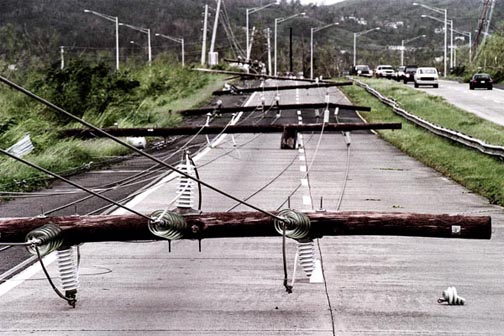CIAPR: Most hurricane damage due to weak structures


On Sept. 18, 1989, Puerto Rico faced the wrath of Hurricane Hugo, which left a path of severe destruction in its wake. (Credit: © Mauricio Pascual)
The new President of the College of Engineers and Surveyors of Puerto Rico (CIAPR by its initials in Spanish), Pablo Vázquez-Ruiz warned Monday that most of the damages on record during hurricanes on the island are due largely to the lack of construction resistance and lack of preparation.
“The housing construction in vulnerable steep terrains and ravines in Puerto Rico, without the intervention of a licensed engineer, or extensions to structures where without permits or formal design is a serious public safety problem,” he said, commenting ahead of the possible strike by potentially catastrophic Hurricane Irma to Puerto Rico.
“This type of fragile structure and improvised construction is a danger at any time, but even more so during the hurricane season that we live in Puerto Rico half of the year,” Vázquez-Ruiz said.
He recommended that each family make an analysis of the susceptibility of their residence or business for elements such as winds, rain and sudden floods, landslides, erosion and/or storm surge, problems that are dramatically sharpened in Puerto Rico where informal construction is so prevalent.
“The experience of the damage left by past hurricanes on our island has shown that many people are unaware of the vulnerability of their homes,” the engineer said.
“Many of the homes that in the past suffered losses or were destroyed could have weathered the strength of the hurricane if they had been built according to established codes or if they had adequate protection for windows and doors,” said Vázquez-Ruiz.
He urged the population to determine the protective measures that need to be taken in each household. For example: securing structures that can be detached and anchored correctly (zinc roofs or roof tiles, solar panels, etc.), trees that can fall, susceptible electric lines near the residence or business, proximity to ravines and drainage works, etc.
“You have to check the structural connections of your house if it is made of wood. The ceiling, walls, floor and foundations must be united by metal anchors that are obtained in the hardware stores with their catalogs of how to use them. There are anchors for each connection,” he said, sharing a link on how to go about it.
“If you live in a weak building, you do not security shutters, especially in glass doors and windows, and if you’re in an area that is flooded or landslides have occurred, or you live near the sea, make no mistake, your residence is not safe,” he said.
Meanwhile, Puerto Rico Insurance Commissioner Javier Rivera-Ríos, reminded citizens, especially business owners, of the importance of reviewing their insurance policies to help face any losses due to a natural weather event, such as Hurricane Irma, which could slide by the island as a Category 4 storm.
Rivera-Ríos said there are many products on the market that can support citizens to deal with losses caused by hurricanes or floods and urged citizens to verify the validity of their property policies, to ensure the type of coverage offered to them and to validate that any payment of the renewal policy has been properly applied by the insurer.
“We live in an area prone to hurricanes and floods so citizens must always be prepared,” Rivera-Ríos said.
As part of that preparation, Rivera-Ríos urged taking the necessary measures to protect property to mitigate damages and possible future losses.











